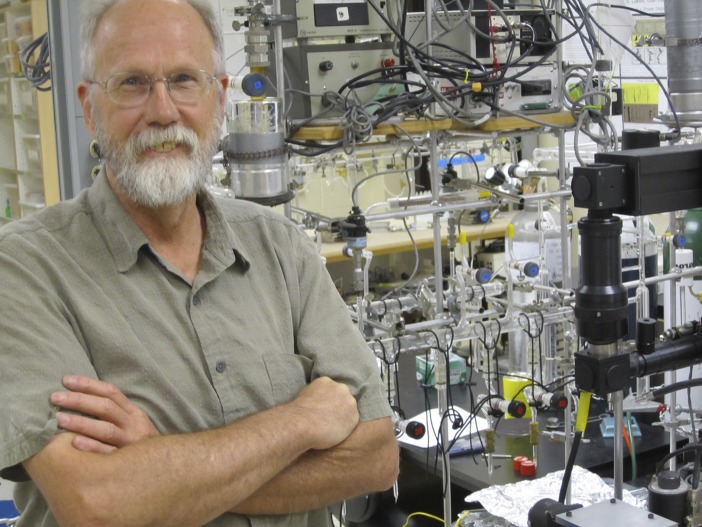Thure Cerling in his laboratory. Image courtesy of Lee Siegel, University of Utah.
Gases liberated from microscopic fragments of teeth dissolved in acid flow down networks of blown-glass tubes in geochemist Thure Cerling’s laboratory at the University of Utah. From these gases, Cerling and his colleagues hope to find secrets of human evolution.
As the hardest material in the body, teeth usually outlast bones. As such, they could serve as time capsules, preserving clues about the lives of ancient primates, including hominins: humans and their closest relatives.
Cerling and his colleagues use diamond-tipped high-speed drills to extract samples from teeth millions of years old collected by fossil-hunting teams in Kenya for nearly 50 years. These samples include specimens from Homo, the human lineage; Australopithecus, the likely immediate ancestral genus of Homo; Paranthropus, whose massive jaw and huge molars have earned it the mistaken nickname of “Nutcracker Man”; and Theropithecus, baboon-like primates that have long lived beside hominins in East and South Africa.
The researchers focus on isotopes of carbon in tooth enamel. The warm-season grasses that dominate savannas all practice C4 photosynthesis, which uses both carbon-12 and the heavier carbon-13 isotope. On the other hand, trees, shrubs, herbs, and cool-season grasses—such as wheat, barley, rye, and oats—depend on C3 photosynthesis, which also takes up carbon-12 and carbon-13, but prefers carbon-12. By analyzing ratios of these different carbon isotopes within teeth, the researchers can infer what they might have eaten; by analyzing these ratios within ancient soils collected from the same areas, the investigators can deduce the ways hominin environments changed over time.
The researchers wanted to analyze samples from ancient teeth for more than 20 years, but for a long time museums balked. “The method was too destructive, requiring too much material,” Cerling says. “One of the things we had to do was to be able to work on smaller samples.” The investigators now analyze less than one milligram of enamel per tooth, about 50- to 100-times less material than before, because of improvements in scientific instruments and sample preparation.
After tooth enamel or soil carbonate samples are dissolved in acid, the resulting gases stream through tubes and get frozen with liquid nitrogen. Water and carbon dioxide are separated via exposure to another cold trap containing a mix of ethanol and dry ice; although water freezes at such temperatures, carbon dioxide does not. The researchers then analyze the carbon isotopes within the carbon dioxide.
Such research now shows there was a dramatic change in diet of early hominins over time from a diet based nearly exclusively on the C3 photosynthesis of trees and shrubs, much like chimpanzees, toward a foundation more on C4 photosynthesis seen in grasses, sedges, and succulents common in tropical savannas and deserts, a shift first seen with Australopithecus afarensis and continuing with all hominins that follow. By about two million years ago, hominins in the Turkana Basin in Kenya had split into two very distinct groups, with Paranthropus’ diet based 75% on C4 and only 25% on C3; Homo kept at 65% C4 and 35% C3. In addition, Theropithecus, which relied largely on a C4 diet, also apparently moved virtually exclusively to a C4 diet during this time.
Although such work cannot tell if, for example, hominins ate more of these plants or preyed more on animals that relied on such plants, this is “a huge advance in our understanding of the diets of early human ancestors and their relatives,” Cerling says.
Footnotes
See Commentary on page 10470.



